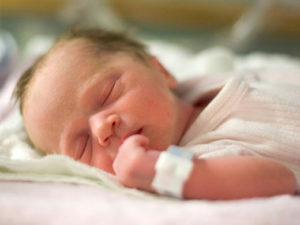 The mother is an important source of the first microbiome for infants by "seeding" the baby's microbiome - from the vaginal birth and then breastfeeding. However, research finds that infants born by C-section acquire bacteria commonly found on skin (Staphylococcus, Corynebacterium, and Propionibacterium) rather than the bacteria acquired during a vaginal birth.
The mother is an important source of the first microbiome for infants by "seeding" the baby's microbiome - from the vaginal birth and then breastfeeding. However, research finds that infants born by C-section acquire bacteria commonly found on skin (Staphylococcus, Corynebacterium, and Propionibacterium) rather than the bacteria acquired during a vaginal birth.
This study examined the source of the skin-type bacteria found on C-section babies. The researchers analyzed the dust from operating rooms (which they collected right after C-sections) and found that it contains deposits of human skin bacteria and human skin flakes. The researchers point out that "Humans shed up to 37 million bacterial genomes into the environment per hour." Operating rooms are occupied by humans, lack natural ventilation, and even though they are regularly cleaned, the humans using the operating rooms shed bacteria and skin flakes. From Microbiome:
The first microbial environment of infants born by C-section: the operating room microbes
Newborns delivered by C-section acquire human skin microbes just after birth, but the sources remain unknown. We hypothesized that the operating room (OR) environment contains human skin bacteria that could be seeding C-section born infants. To test this hypothesis, we sampled 11 sites in four operating rooms from three hospitals in two cities. Following a C-section procedure, we swabbed OR floors, walls, ventilation grids, armrests, and lamps....The bacterial content of OR (operating room) dust corresponded to human skin bacteria, with dominance of Staphylococcus and Corynebacterium. Diversity of bacteria was the highest in the ventilation grids and walls but was also present on top of the surgery lamps.
We conclude that the dust from ORs, collected right after a C-section procedure, contains deposits of human skin bacteria. The OR microbiota is the first environment for C-section newborns, and OR microbes might be seeding the microbiome in these babies.
In the present study, we used 16S rRNA gene sequencing to show that OR dust, collected right after a C-section procedure, contains bacteria similar to human skin microbiota. Previous studies using culture-dependent methods also showed that over 85 % of air samples from ORs had skin-like bacteria which were mostly coagulase-negative staphylococci and Corynebacterium. These airborne skin-bacteria could be from individuals present during C-section but could also be shed by cleaning personnel between operations.
In our study, 30 % of samples failed to yield sufficient DNA sequences to be analyzed. While there are no published data on the microbiota in operating rooms using 16S rRNA gene sequencing, very few bacteria (average 3.3–3.5 CFU/10 cm2) were detected in ORs after regular decontamination using standard culturing methods, consistent with the low sequence numbers in our study.
In addition, we found that the microbiota of OR samples was more similar to human skin microbiota than oral microbiota and that OR dust contains deposits of human skin flakes. These results reveal that while the use of surgical masks has limited effectiveness at curtailing oral microbial shedding, skin flakes from individuals present during C-section and/or from cleaning personnel between operations could be a more influential factor contributing to the structure of OR microbiota.
Our SourceTracker analysis results suggest that the OR microbes could play a role in seeding infants born by C-section. C-section born infants, in particular, may be solely receiving this inoculum, while vaginally born infants have exposure to vaginal bacteria. The results of these further studies could be relevant to the possible effects on the priming of the immune system by skin bacteria from environmental sources as the primordial inoculum seeding the infant microbiome. This might be relevant to the increased risk of immune diseases observed in C-section born infants.
